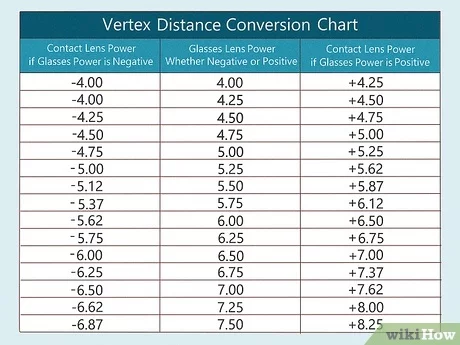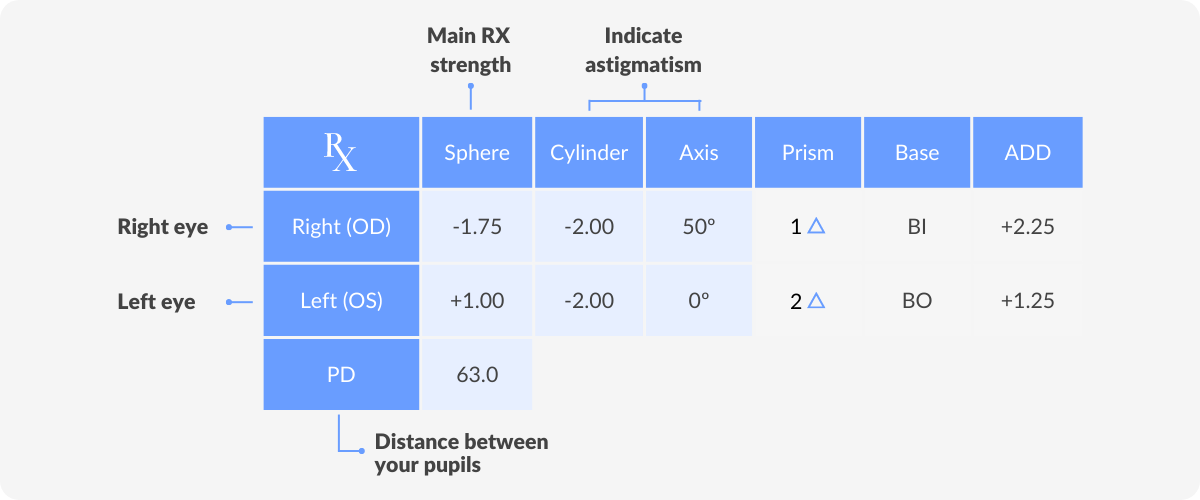glasses prescription to contacts conversion. If you wear glasses and want to try contact lenses, you might wonder how to convert your glasses prescription to contacts. You might think that you can just use the same prescription for both, but that is not the case. Glasses and contact lenses are different types of vision correction devices that require different prescriptions. In this article, we will explain why glasses and contact lenses have different prescriptions, how to convert your glasses prescription to contacts, and what factors to consider when choosing contact lenses.
Key Takeaways
- Glasses and contact lenses have different prescriptions because they are placed at different distances from your eyes and have different effects on your vision.
- To convert your glasses prescription to contacts, you need to use a conversion chart or a formula that takes into account the distance between your glasses and your eyes, the lens power, and the base curve of the contact lenses.
- You also need to consider other factors when choosing contact lenses, such as the diameter, the material, the replacement schedule, and the brand.
- You should always consult your eye doctor before switching from glasses to contact lenses, as they can provide you with a proper contact lens fitting, prescription, and advice.
Why Glasses and Contact Lenses Have Different Prescriptions
Glasses and contact lenses are different types of vision correction devices that work by bending the light rays that enter your eyes and focusing them on your retina. However, glasses and contact lenses are placed at different distances from your eyes and have different effects on your vision.
Glasses are usually worn about 12 millimeters away from your eyes, while contact lenses sit directly on your cornea. This means that glasses have a longer optical path than contact lenses, and therefore need more lens power to correct your vision. Contact lenses, on the other hand, have a shorter optical path than glasses, and therefore need less lens power to correct your vision.
Another difference between glasses and contact lenses is that glasses have a fixed shape and size, while contact lenses conform to the shape and curvature of your eyes. This means that glasses have a constant effect on your vision, regardless of how you move your eyes or head. Contact lenses, on the other hand, have a variable effect on your vision, depending on how they fit and move on your eyes.
Because of these differences, glasses and contact lenses have different prescriptions that specify the lens power, the base curve, and the diameter of the lenses. The lens power is the amount of correction needed to focus the light rays on your retina. The base curve is the curvature of the back surface of the lens that matches the curvature of your cornea. The diameter is the width of the lens that covers your cornea.
How to Convert Your Glasses Prescription to Contacts
To convert your glasses prescription to contacts, you need to use a conversion chart or a formula that takes into account the distance between your glasses and your eyes, the lens power, and the base curve of the contact lenses. You also need to measure the diameter of your cornea, which is usually done by your eye doctor.
The conversion chart is a table that shows the equivalent contact lens power for different glasses powers and vertex distances. The vertex distance is the distance between the back surface of the glasses lens and the front surface of the cornea. You can use a ruler to measure the vertex distance, or use the average value of 12 millimeters.
To use the conversion chart, you need to find the row that corresponds to your glasses power and the column that corresponds to your vertex distance. The intersection of the row and the column will give you the contact lens power. You can use the same chart for both positive and negative powers, but you need to reverse the sign. For example, if your glasses power is +5.00 diopters and your vertex distance is 12 millimeters, your contact lens power is -4.75 diopters. If your glasses power is -5.00 diopters and your vertex distance is 12 millimeters, your contact lens power is +4.75 diopters.
Here is an example of a conversion chart:
| Glasses Power | Vertex Distance (mm) |
|---|---|
| 10 | |
| +1.00 | -0.90 |
| +2.00 | -1.82 |
| +3.00 | -2.73 |
| +4.00 | -3.64 |
| +5.00 | -4.55 |
| +6.00 | -5.45 |
The conversion formula is a mathematical equation that calculates the contact lens power based on the glasses power and the vertex distance. The formula is:
P_c = \frac{P_g}{1 – d \times P_g}
whereP_cis the contact lens power,P_gis the glasses power, anddis the vertex distance in meters. You need to convert the vertex distance from millimeters to meters by dividing it by 1000. For example, if your vertex distance is 12 millimeters, you need to divide it by 1000 to get 0.012 meters.
To use the conversion formula, you need to plug in the values of your glasses power and your vertex distance into the equation and solve for the contact lens power. You can use the same formula for both positive and negative powers, but you need to reverse the sign. For example, if your glasses power is +5.00 diopters and your vertex distance is 12 millimeters, your contact lens power is:
P_c = \frac{5}{1 – 0.012 \times 5}
P_c = \frac{5}{0.94}
P_c = 5.32
P_c = -5.32 \text{ diopters}
If your glasses power is -5.00 diopters and your vertex distance is 12 millimeters, your contact lens power is:
P_c = \frac{-5}{1 – 0.012 \times (-5)}
P_c = \frac{-5}{1.06}
P_c = -4.72
P_c = +4.72 \text{ diopters}
The conversion chart and the conversion formula are only approximate methods to convert your glasses prescription to contacts. They do not take into account other factors that may affect your contact lens prescription, such as the base curve, the diameter, the material, the replacement schedule, and the brand. Therefore, you should always consult your eye doctor before switching from glasses to contact lenses, as they can provide you with a proper contact lens fitting, prescription, and advice.
This is the end of the first part of the article. I hope you found it helpful and informative. If you want to read the second part of the article, please let me know. Thank you for using Bing. 😊
How to Convert Your Glasses Prescription to Contacts: A Simple Guide (Continued)
In the first part of this article, we explained why glasses and contact lenses have different prescriptions, how to convert your glasses prescription to contacts, and what factors to consider when choosing contact lenses. In this part, we will show you how to read your contact lens prescription, how to order contact lenses online, and how to take care of your contact lenses.
How to Read Your Contact Lens Prescription
Your contact lens prescription is a document that specifies the parameters of the contact lenses that you need to correct your vision. Your contact lens prescription may differ from your glasses prescription, as they are based on different measurements and calculations. Your contact lens prescription may also vary depending on the type and brand of contact lenses that you use.
Your contact lens prescription may include the following information:
- OD and OS: These are abbreviations for oculus dexter and oculus sinister, which are Latin terms for right eye and left eye. Your contact lens prescription may have different values for each eye, as they may have different levels of refractive errors.
- PWR or SPH: This is the power or sphere of the contact lens, which is the amount of correction needed to focus the light rays on your retina. It is measured in diopters, which are units of lens power. A positive value indicates that you are farsighted, and a negative value indicates that you are nearsighted.
- BC or BCR: This is the base curve or base curve radius of the contact lens, which is the curvature of the back surface of the lens that matches the curvature of your cornea. It is measured in millimeters, and it determines how well the contact lens fits and moves on your eye. A lower value indicates a steeper curve, and a higher value indicates a flatter curve.
- DIA: This is the diameter of the contact lens, which is the width of the lens that covers your cornea. It is measured in millimeters, and it determines how comfortable and stable the contact lens is on your eye. A smaller value indicates a narrower lens, and a larger value indicates a wider lens.
- CYL and AXIS: These are the cylinder and axis of the contact lens, which are the parameters that correct astigmatism. Astigmatism is a condition where your cornea or lens has an irregular shape, causing blurred or distorted vision. The cylinder is the amount of correction needed to correct the irregularity, and the axis is the angle at which the correction is applied. The cylinder is measured in diopters, and the axis is measured in degrees. A zero value for the cylinder indicates that you do not have astigmatism, and a non-zero value indicates that you do.
- ADD: This is the add power of the contact lens, which is the additional correction needed to correct presbyopia. Presbyopia is a condition where your lens loses its ability to focus on near objects, causing difficulty in reading or seeing small details. The add power is measured in diopters, and it is added to the power of the contact lens to create a multifocal or bifocal lens. A zero value for the add power indicates that you do not have presbyopia, and a non-zero value indicates that you do.
- COLOR: This is the color of the contact lens, which is the tint or hue that changes the appearance of your eye color. The color of the contact lens may be cosmetic or functional, depending on your preference and needs. A cosmetic color is used to enhance or change your natural eye color, and a functional color is used to improve your vision or comfort. For example, some contact lenses have a visibility tint, which is a light blue or green color that helps you see and handle the contact lens better.
- BRAND: This is the brand of the contact lens, which is the name of the manufacturer or the product line that produces the contact lens. The brand of the contact lens may affect the quality, performance, and price of the contact lens, depending on the reputation and features of the brand. Some examples of contact lens brands are Acuvue, Air Optix, Biofinity, Dailies, and Freshlook.
Here is an example of a contact lens prescription:
| Eye | PWR | BC | DIA | CYL | AXIS | ADD | COLOR | BRAND |
|---|---|---|---|---|---|---|---|---|
| OD | -2.00 | 8.6 | 14.2 | -0.75 | 180 | +1.00 | Blue | Acuvue |
| OS | -1.50 | 8.6 | 14.2 | -1.00 | 170 | +1.00 | Blue | Acuvue |
How to Order Contact Lenses Online
Ordering contact lenses online can be a convenient and cost-effective way to get your contact lenses delivered to your door. However, you need to be careful and follow some steps and guidelines to ensure that you order the right contact lenses for your eyes and your vision.
To order contact lenses online, you need to do the following:
- Get a valid contact lens prescription from your eye doctor. You need to have a recent eye exam and a proper contact lens fitting to get a valid contact lens prescription. Your contact lens prescription may expire after a certain period of time, usually one or two years, depending on your location and your eye condition. You need to renew your contact lens prescription before it expires, or you may not be able to order contact lenses online.
- Choose a reputable and reliable online contact lens retailer. You need to do some research and compare different online contact lens retailers, based on their prices, products, services, reviews, and ratings. You need to choose an online contact lens retailer that offers the contact lenses that you need, at a reasonable price, with a fast and secure delivery, and with a good customer service and return policy. Some examples of online contact lens retailers are 1-800 Contacts, Lens.com, Coastal, and ContactsDirect.
- Enter your contact lens prescription and your personal information. You need to enter your contact lens prescription accurately and correctly, as it determines the parameters of the contact lenses that you will receive. You also need to enter your personal information, such as your name, address, phone number, and email address, as it determines the delivery and the communication of your order. You may also need to enter your eye doctor’s information, such as their name, phone number, and email address, as some online contact lens retailers may need to verify your contact lens prescription with your eye doctor before processing your order.
- Choose your contact lens quantity and frequency. You need to choose how many contact lenses you want to order, and how often you want to receive them. This depends on the type and the replacement schedule of the contact lenses that you use, as well as your personal preference and budget. For example, if you use daily disposable contact lenses, you may want to order a 90-day supply and receive it every three months. If you use monthly disposable contact lenses, you may want to order a 6-month supply and receive it every six months.
- Choose your payment method and confirm your order. You need to choose a payment method that is secure and convenient for you, such as a credit card, a debit card, a PayPal account, or a gift card. You need to enter your payment information, such as your card number, expiration date, security code, and billing address, and confirm your order. You should also review your order details, such as your contact lens prescription, your personal information, your contact lens quantity and frequency, and your payment method, and make sure that they are correct and complete. You should also read and agree to the terms and conditions, the privacy policy, and the return policy of the online contact lens retailer, and submit your order.
How to Take Care of Your Contact Lenses
Taking care of your contact lenses is important to maintain your eye health and your vision quality. You need to follow some steps and guidelines to ensure that you use and store your contact lenses properly and safely.
To take care of your contact lenses, you need to do the following:
- Wash your hands before handling your contact lenses. You need to wash your hands thoroughly with soap and water, and dry them with a lint-free towel, before touching your contact lenses. This is to prevent any dirt, germs, or oils from getting on your contact lenses and causing infections or irritations to your eyes.
- Clean and disinfect your contact lenses after each use. You need to clean and disinfect your contact lenses after each use, using a contact lens solution that is compatible with your contact lenses and recommended by your eye doctor. You need to follow the instructions on the contact lens solution bottle, and rub and rinse your contact lenses with the solution, and then soak them in a clean contact lens case with fresh solution. This is to remove any deposits, bacteria, or debris from your contact lenses and keep them moist and comfortable.
- Replace your contact lenses and your contact lens solution according to the schedule. You need to replace your contact lenses and your contact lens solution according to the schedule that is prescribed by your eye doctor and indicated by the contact lens manufacturer. This depends on the type and the replacement schedule of the contact lenses that you use, as well as your eye condition and your wearing habits. For example, if you use daily disposable contact lenses, you need to replace them every day and discard them after each use. If you use monthly disposable contact lenses, you need to replace them every month and discard them after 30 days of use. You also need to replace your contact lens solution every day and discard the old solution after each use.
- Do not wear your contact lenses longer than recommended. You need to follow the wearing time that is



